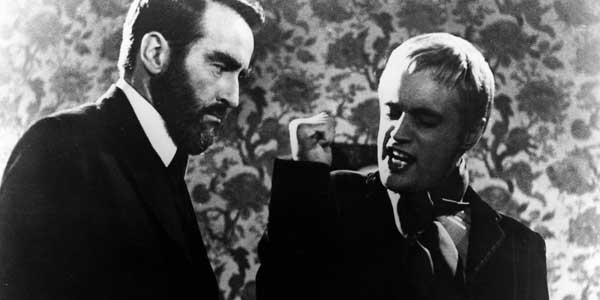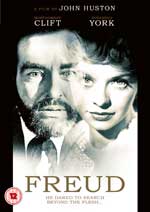
Director: John Huston
Running Time: 134 mins
Certificate: 12
Release Date: April 23rd, 2012

It’s very peculiar that despite Montgomery Clift and Susannah York starring in the film and the legendary John Huston behind the camera, Freud has never been legally available on either VHS or DVD in the UK. That’s now being addressed with this release, which gives a fresh outing for the unusual biopic.
Rather than covering the whole of Sigmund Freud’s life, the film concentrates on the years from 1885 to 1890 when he was developing his most famous theories. Against the backdrop of a medical establishment who believed mental problems either had a physiological cause or were just people pretending, Freud began to explore the idea of the unconscious and his ‘talking cure’, which sought to uncover memories the patient had suppressed and by unlocking them, cure the problems they faced (or at least that’s the overly simplified way it works in the film).
Freud faces the scorn of his colleagues who react badly to much of what he was to say, particularly when he starts to explore ideas of childhood sexuality and the Oedipus effect. The second half of the film concentrates on Freud’s relationship with one particular patient (Susannah York), who has hysterical paralysis. The doctor slowly begins to uncover the traumas and difficulties of her youth, hoping it will allow her to walk again.
There’s no doubt that the film oversimplifies psychological thinking and seems hopelessly outdated on that score in the present day. There are also plenty of modern day mental health professionals who aren’t big fans of Freud and who will take issue with the film’s glowing portrait of him (there’s no doubt Sigmund was as much a master of self-promotion and creating his own narrative, which the film buys into completely, as a master of the human mind). However it’s a fascinating attempt to mix a traditional biopic with more experimental elements, such as rather surreal dreams sequences.
As director John Huston’s voiceover suggests, it’s a film that’s less interested in Freud himself than the possibilities of unlocking the human mind and how that can be shown on screen – how can you portray the ideas of psychology on screen? As a result it plays fast and loose with history in favour of trying to uncover what Freud’s ideas mean. It is an interesting and entertaining movie, with a great central performance from Montgomery Clift. While Hollywood legend say John Huston tortures Clift on the set of the movie, asking more from him than was reasonable to expect, there little evidence for that.
However the alcoholic Clift was badly ailing when he made the movie, and his ill health caused so many delays and overruns that Universal eventually tried to sue him over it. After Freud in 1962, he didn’t make another movie until 1966’s The Defector, which he filmed just a few months before he died at the age of only 45. Considering his problems it’s almost ironic to have him playing Freud, with acting teacher Robert Lewis describing his death as ‘longest suicide in history’. Clift’s alcoholism, depression and self-destructive behaviour was largely due to his inability to come to terms with his sexuality (something that wasn’t uncommon at the time, especially as homosexuality was illegal), and while he spent a lot of time on the psychologist’s couch, it didn’t help.
The movie is also, incidentally, thought to be the first Hollywood production that touches explicitly on incest, which comes up when Susannah York’s character is slowly uncovering the reasons for her hysteria.
However while the movie is good, the DVD is less so, as it’s not in anamorphic widescreen. Instead it’s a letterboxed picture, meaning you have zoom in (and therefore lose picture quality) to fill a widescreen TV. While it saves money using a non-anamorphic master, it’s slightly unforgivable in the modern age.
Overall Verdict: A fascinating movie and Clift is always worth watching, but using a non-anamorphic print in 2012 is a big no-no.
Reviewer: Tim Isaac





Leave a Reply (if comment does not appear immediately, it may have been held for moderation)